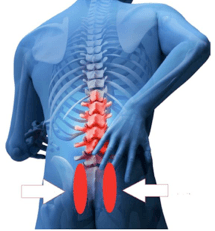Each of us has two SI or sacroiliac joints in our lower back.
On a good day, they are responsible for carrying our upper body and keeping us balanced by shifting weight to our legs while we walk, run, stand and jump.
On a bad day, they can flare up and cause extreme amounts of pain over seemingly ordinary movements - like bending over to pick up a sock or getting up out of a chair. If this sounds like you, you’re not alone. Studies have shown that as much as 25% of all lower back pain can be attributed to the SI joint. (1,2)

To understand the pain, you need to understand the joint itself. The SI joint has a large number of free nerve endings (known as a synovial joint) in the joint itself. These nerve endings can be triggered by a number of causes - from joint degeneration and improper movement (hypermobility or hypomobility) to excess weight or stress to an accident or fall. It can also be caused by the changes to a woman’s body surrounding pregnancy.
The result could be sharp or dull. It could stay in the lower back, or radiate down through the pelvis, thighs and buttocks down into the legs. And while SI pain is more common in young to middle-aged women, it can be felt by both men and women of all ages.
The pain from SI joint disfunction can often be difficult to diagnose as it can mimic other orthopedic conditions such as discogenic pain, facet syndrome and sciatic pain. A detailed physical exam, which may include X-ray and/or MRI, is often required to properly diagnose the source of the pain.
Because the causes are so diverse, so too are the ways we treat SI pain. For some, physical therapy, stretching and possible bracing can produce positive results. For others, fluoroscopic guided steroid injections prove more successful. In some rare cases, surgery can also be an option.
For stretches specific to SI joint pain, see the attached stretches.
If you suffer from the symptoms of SI joint pain and would like to schedule an evaluation, please contact our office for an appointment.
1-Bernard TN, Kirkaldy-Willis WH. Recognizing specific characteristics of nonspecific low back pain. Clinical Orthopedics 1987;217:266–80.
2-Cohen, Steven P. Sacroiliac Joint Pain: A Comprehensive Review of Anatomy, Diagnosis, and Treatment. Anesth Analg 2005; 101:1440-1453.






